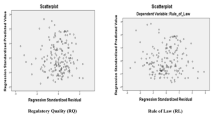Abstract
The purpose of this article is to explore the relationship between governance indicators developed by the World Bank and global competitiveness measured by the World Economic Forum. The findings show that most of the governance clusters have a significant influence on the global competitiveness. It is further discovered that government effectiveness, regulatory quality, rule of law and control of corruption are influencing governance indicators for countries from Europe, South and Central America and Asia, while for countries from Africa the global competitiveness seems to be least influenced by all six governance dimensions.
Similar content being viewed by others
Notes
See the “Appendix” for descriptions of all variables and data sources.
References
Acemoglu D, Johnson S, Robinson A (2001) The colonial origins of comparative development: an empirical investigation. Am Econ Rev 91(5):1369–1401
Busse M, Gröning S (2009) Does foreign aid improve governance? Econ Lett 104:76–78
Çule M, Fulton ME (2013) Corporate governance and subjective well-being. Appl Econ Lett 20:364–367
Kaufmann D, Kraay A, Zoido-Lobaton P (1999a) Aggregating governance indicators. World Bank Policy, Research Working Paper No. 2195. The World Bank, Washington DC
Kaufmann D, Kraay A, Zoido-Lobaton P (1999b) Governance matters. World Bank Policy, Research Working Paper No. 2196. The World Bank, Washington DC
Knack S, Keefer P (1997) Why don’t poor countries catch up? A cross-national test of an institutional explanation. Econ Inq 35:590–602
Kray A, Tawara N (2010) Can disaggregated indicators identify governance reform priorities? The World Bank Development Research Group, Policy Research Working Paper no. 5254
Ng KYA, Gujar GC (2009) Government policies, efficiency and competitiveness: the case of dry ports in India. Transp Policy 16:232–239
Price R, Román FJ, Rountree B (2011) The impact of governance reform on performance and transparency. J Financ Econ 99:76–96
Rodrik D (1997) TFPG controversies, institutions and economic performance in East Asia. NBER Working Paper, no. W5914
Rodrik D, Subramanian A, Trebbi F (2004) Institutions rule: the primacy of institutions over geography and integration in economic development. J Econ Growth 9(2):131–165
Sala-i-Martín X, Artadi EV (2004) The Global Competitiveness Index. The Global Competitiveness Report 2004–2005. Palgrave Macmillan, Hampshire
World Bank, 2012 Worldwide Governance Indicators (WGI) project 1996–2011. http://info.worldbank.org/governance/wgi/index.asp. Accessed 1 Oct 2012
World Bank, ‘Country and Lending Groups’ (2012) Online access at http://data.worldbank.org/about/country-classifications/country-and-lending-groups#Low_income. Accessed 2 Oct 2012
World Economic Forum (2012) Global Competitiveness Report 2012–2013. http://www.weforum.org/. Accessed 15 Oct 2012
Author information
Authors and Affiliations
Corresponding author
Appendix
About this article
Cite this article
Boţa-Avram, C. The Interplay Between Governance and Global Competitiveness: Evidence from a Cross-Country Survey. Transit Stud Rev 20, 381–388 (2013). https://doi.org/10.1007/s11300-013-0291-5
Published:
Issue Date:
DOI: https://doi.org/10.1007/s11300-013-0291-5




